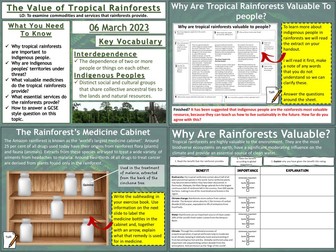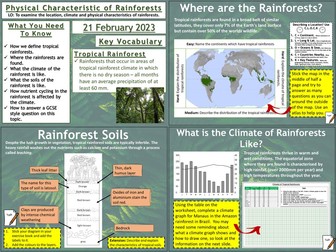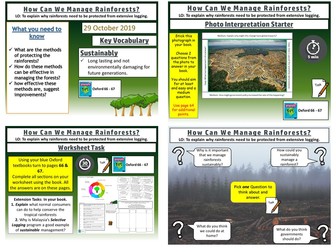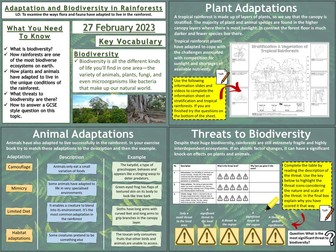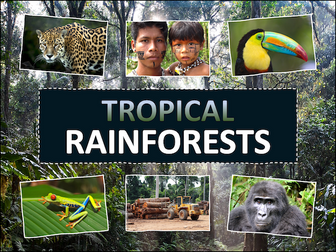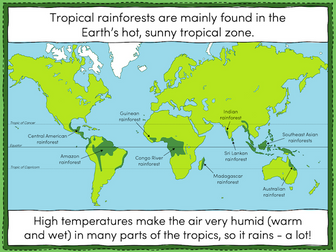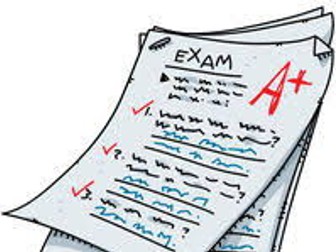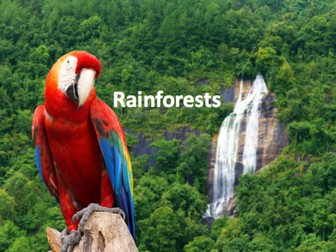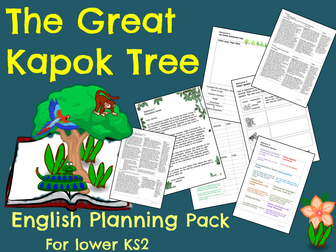
The Value of Tropical Rainforests
AQA GCSE Geography lesson for the new specification Unit 1B: In this lesson we look at what valuable commodities and services the rainforest provides.
The lesson has a rainforest themed retrieval practice starter. We look at what value the rainforest has to indigenous peoples and why these people may be at threat. Focusing on the Achua tribe we look at a video and complete some guided reading with the students completing some questions relating to the text. We then look at the valuable medicines that come from the rainforest, the students have to complete an annotated ‘rainforest cabinet’ using information from the slide. We then look at essential services. The students read the information on the various services the rainforest provides and rate them according to how important they are and explain why they think this. We finish with a GCSE-style practice question with some guidance and structure provided for the students.
Hope this saves you some valuable planning time.
https://www.tes.com/teaching-resources/shop/markthegeographer

Physical Characteristics of Rainforests
AQA GCSE Geography lesson for the new specification Unit 1B: In this lesson we look at what the physical characteristics of tropical rainforests are.
The lesson has a retrieval practice starter quiz on rivers to begin with. We then look at what it is like to be in the rainforest with a short video clip of walking through the forest. We then look at the location of tropical rainforests and the students have a map with some questions of differing difficulty to answer. The students are provided with a worksheet to draw a climate graph of the rainforest with some additional skills questions to answer (works well with a visualiser). The students complete an annotated profile of the rainforest latosol soil, describing and explaining its characteristics. We then look at the nutrient cycle and the students annotate a diagram making sure they eliminate the incorrect word from the annotation. We finish with a GCSE-style practice question with some guidance and structure provided for the students.
Hope this saves you some valuable planning time.
https://www.tes.com/teaching-resources/shop/markthegeographer

Sustainable Management of Tropical Rainforests
For AQA GCSE Geography. You need the Oxford AQA GCSE Geography Textbook for the new specification
The lesson includes.
Photo interpretation starter.
Questioning activity
Video clips
Large A3 worksheet with a variety of different activities covering the required content.
Plenary activity.
All worksheets for photocopying included. Hope this helps.
https://www.tes.com/teaching-resources/shop/markthegeographer

Adaptation and Biodiversity in Rainforests
AQA GCSE Geography lesson for the new specification Unit 1B: In this lesson we look at what how plants and animals have adapted to the environmental conditions in the rainforest.
The lesson has a retrieval practice starter to begin with. We then look at what biodiversity is and why the rainforests are particularly diverse. We then look at rainforest stratification and plant adaptations. The students have a sheet to complete and some information slides to use to complete the sheet. This could be used as a carousel or group work task. The sheet can even be coloured in! Then the students complete a mix and match up task on the most common types of animal adaptations. The students then complete a rating task with explanation as to how significant are threats to biodiversity in the rainforest. We finish with a GCSE-style practice question with some guidance and structure provided for the students.
Hope this saves you some valuable planning time.
https://www.tes.com/teaching-resources/shop/markthegeographer
Bundle

Tropical Rainforests - KS2
Tropical Rainforests is a Geography unit designed for students in KS2 (Y3-6).
The planning overview, topic title page and a knowledge organiser can be downloaded for free here. Lessons include:
L1 – Locating tropical rainforests on a world map
L2 – Identifying tropical rainforest animals
L3 – Investigating the layers of a tropical rainforest
L4 – Exploring the Amazon rainforest
L5 – Understanding the impact of deforestation on the Amazon
L6 – Investigating how deforestation affects an Amazon tribe
L7 - Thinking of ways to help save tropical rainforests
Each lesson includes a presentation and differentiated activities/worksheets. A knowledge organiser is also included. All resources are compatible with both Microsoft Office and Google Workspace.
If you like this resource, we would appreciate a review! We will happily send you a free resource in return for a review or useful suggestions/feedback. Contact us at ed@teachitforward.co.uk.
undefined

Locating tropical rainforests on a world map - KS2
This lesson is part of Tropical Rainforests, a Geography unit designed for students in KS2, but can also be taught as a stand alone lesson. All resources are compatible with both Microsoft Office and Google Workspace.
The presentation introduces students to tropical rainforests, including some of the flora and fauna that live in them. Students then learn about the Earth’s tropical belt and the location of the various rainforests within it.
The activity challenges students to label features of a world map including the Equator, the Tropic of Cancer and the Tropic of Capricorn. Students then locate 8 of the world’s tropical rainforests.
Easier - Students use a prompt map and have activity clues.
Harder - Students use a prompt map but have no activity clues.
Extension - Students fill in the missing words in a paragraph about tropical rainforests.
If you like this resource, we would appreciate a review! We will happily send you a free resource in return for a review or useful suggestions/feedback. Contact us at ed@teachitforward.co.uk.

Tropical Rainforests worksheet
Work mat for tropical rainforests topic. Suitable for KS3 classes. Could be used as a lesson resource, cover work or homework.

Amazon Rainforest Layers KS2
Amazon Rainforest Layers teaching Power Point and activities. Updated version.
Are you learning about the Amazon rainforest? This product includes a teaching PPT and fun activities that will really help children learn about the different layers of the rainforest, the animals and plants that can be found in the Amazon and how the animals and plants have adapted to life in the Amazon rainforest.
This product also includes activities for students with special educational needs and those that are learning English as an additional language, allowing them to access the curriculum at their own level.
Updated Product Includes:
14 slide informational power point
differentiated reading comprehension x 2
cut and paste vocabulary activity
place the animals in the correct layer cut and paste activity
choice of writing activities:
4 part writing frame
choice of 3 flipbooks
design an Amazon animal
exit tickets for assessment
4 colourful posters for display
real life pictures for display
Amazon Activities for special educational needs/ESL students:
Make an Amazon Rainforest Layers vocabulary book - colour and b/w version
Picture word cards to use with activities
Reading comprehension x 2 differentiated
Match words and picture cards
Mixed up sentences - match to picture
Writing frames with word bank x 2
Word search and label activity
Colour and label activity
Original Product Contents:
Everything you need to make a flipbook of the different layers - children to write about each layer and draw pictures of the animals and plants that can be found in each layer.
Everything you need to make a flip book about how animals have adapted to life in the Amazon rainforest and a book about how plants have adapted to live in the Amazon rainforest.
4 non fiction reading comprehensions and questions - one on each layer,
A colour and stick activity - animals that live in the different layers.
A power point detailing each layer - the animals and plants that thrive there and how they have adapted.
By the end of these activities children should have a good knowledge of the different layers of the Amazon rainforest, the animals and plants that can be found there and how they have adapted.
Suitable for children aged 7 years+

Rainforest assessment
This end of unit test assesses pupils understanding of: the distribution and characteristics of tropical rainforest, the causes and effects of deforestation as well as management strategies. A mark scheme is also included.
Sale

Tropical Rainforests Revision Mat (AQA geog GCSE)
AQA Geography GCSE Revision Mat for the Living World - TROPICAL RAINFORESTS
Comes with answers (apart from case study section - feel free to add this for your school’s individual case study).
This is an A3 resource.

Rainforests
Full unit of work for tropical rainforests. All lesson are suitable for 50 minutes to 1 hour of teaching time. Includes supporting worksheets for lessons - no additional resources are required.
All lessons have a starter and lesson objectives. All PowerPoints in the same signature style.
Lesson sequence:
1 - Rainforest introduction
2 - Exploring the wilderness
3 - Layers of the rainforest
4 - Life in the rainforest
5 - Climate of the Amazon
6 - Deforestation
7 - What does deforestation contribute to climate change?
8 - Deforestation mystery
9 - Can we save the rainforests?
10 - ICT research project
11 - Student presentations
12 - Produce from the rainforest
13 - Sustainability
14 - Sustainable tourism
15 - How to survive in the rainforest
16 - End of unit test
Also includes Geography Literacy mat and Geography Numeracy/Map Skills mat.
For more resources visit This is Geography. Full SoW for all new GCSE specifications - AQA, Edexcel, OCR, CIE IGCSE, Edexcel IGCSE and Eduqas. As well as over 200 lessons for KS3 and KS2. Want something bespoke designing? Email us for further details info@thisisgeography.co.uk

Rainforests
Rainforests graphic organizer and vocabulary activities. Help your students learn and remember the important facts about rainforests and the associated vocabulary with these fun, interactive activities.
Print out and laminate the graphic organizers for students to keep and use throughout your topic work. Use the vocabulary cut and stick activity at the beginning of the topic as an introduction/guide to their existing knowledge OR as an end of topic assessment.
Topic word cards for display and word search.
This product includes:
Graphic organizer - colour and black and white version
Vocabulary activity - cut and stick match words/pictures/definitions - colour and b/w
20 topic word cards for display
Word search
Bundle

Rainforests
This unit is created in line with my personal passion for rainforest sustainability. This unit is framed around the both environmental process and human’s impact on these, and also looks to consistently cross over from physical to human geography and back again.
A conscience effect has also been made to embed dual coding within this SoW, as well as much differentiation and debating.
SoW:
L1: What are the causes for the global distribution of Rainforests? (Free download)
L2: What is the Structure of the Rainforest and How Have Animals/Plants Adapted?
L3: How Do Rainforest Provide Both Goods and Services?
L4: Why is there a Range of Risk to the World’s Rainforests?
L5: How the world sustainably manages its rainforests?
L6: Stakeholder Analysis: Who Do the World’s Rainforest Belong to?
L7: Rainforest Extended Writing
thegeographyshoporiginal@gmail.com
Best FREE Resources (The Geography Shop)
https://www.tes.com/teaching-resource/-12899088 (Climate Change SoW)
https://www.tes.com/teaching-resource/-12899440 (Development SoW)
https://www.tes.com/teaching-resource/-12638984 (Waste SoW)
https://www.tes.com/teaching-resource/-12451443 (Britain Globalisation SoW)
https://www.tes.com/teaching-resource/-12741793 (Local Area Investigation SoW)
https://www.tes.com/teaching-resources/bundler/12949461 (Cambridge International)
https://www.tes.com/teaching-resource/-12922653 (Israel & Palestine)
https://www.tes.com/teaching-resource/resource-12485457 (What is Geography?)
I hope you find this SoW useful. If you have, I have created a series of resources.
You can check them out here.
https://www.tes.com/teaching-resources/shop/TheGeographyShopOriginal

The Great Kapok Tree Planning (Rainforest)
This two-week unit of English work, based on the book ‘The Great Kapok Tree’, works well alongside topics about rainforests, sustainability and Mayans. It can also be used as a standalone English unit. The resources are designed for Year 3 and Year 4.
The ten lessons in this unit use drama, discussion and creative activities to help pupils to engage imaginatively with the text. Pupils will become familiar with the structure of dilemma stories and then write and edit their own dilemma stories based on The Great Kapok Tree. There is also a grammar focus on using direct speech and plenty of activities designed to develop vocabulary.
The English objectives covered in this unit are:
- To retrieve information from non-fiction
- To design a ‘great tree’ setting
- To explore the structure of dilemma stories
- To punctuate direct speech correctly
- To use a range of speech verbs
- To use adverbs in dialogue (higher group)
- To identify persuasive devices
- To use a dictionary to find definitions
- To write a persuasive letter
- To prepare a group performance
- To plan a dilemma story
- To write my own dilemma story
- To edit and evaluate my writing
- To use a thesaurus
The PDF file contains 10 lesson plans and accompanying pupil resources.

Rainforest
This set of resources include a four week planning sequence and power point of the dioramas that the children made. When all put together they made a vibrate display on a wall, and create an atmosphere evocative of the rainforest environment.

Rainforest Layers Worksheet
Rainforest Layers Worksheet
Easy to use activity on rainforests and their main layers - emergent, canopy, understory, forest floor. The students can either colour in the main picture of the layers (page one), then cut along the dotted lines and write information under each flap or cut and stick the animal pictures (page two) and match them to the correct layer.
Possible answers for the animals and layers matching included (page three).
Thank you for your interest
HoppyTimes

Rainforests
I created this flipchart to use with my year 5 class. It introduces children to where in the world rainforests are found and then proceeds to identifying the layers of the forest itself. It then looks at the indigenous people who still live their lives within the forests

Rainforest
Rainforest Animals Cootie Catchers/ fortune tellers: These rainforest cootie catchers are a great way for students to have fun while learning about the different types of rainforest animals. These cootie catchers contain the following rainforest Animals:
♦ Frog, Toucan, Anaconda, Chameleon, Monkey, Macaw, Piranha, Sloth
These cootie catchers on rainforest animals come in color and black & white, and also come with a version where students can add their own definitions. All of this totals 6 pages which has students identifying vocabulary terms about rainforest animals (with pictures) based from the definition.

